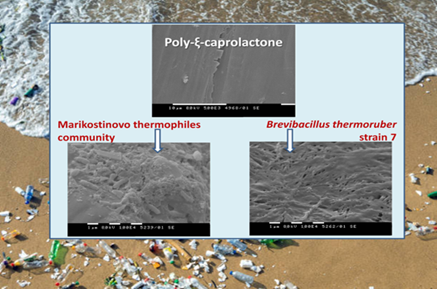
BIOTECHNOLOGIES
A microbial community with an unknown polycaprolactone (PCL) degradation efficiency was isolated from a hot spring in Marikostinovo, Bulgaria. The optimum temperature for the degradation process of 55°C is the highest known so far for PCL degradation.
Changes after 3-week cultivation of Brevibacillus thermoruber strain 7 isolated from the bacterial community.

BIOTECHNOLOGIES
A highly efficient Ru-catalyzed allylic isomerization of renewable Akhmatovich products is reported for the first time. The method developed at the IOCCP-BAS is of importance for biorefinery and green chemistry, as it uses a formally redox-neutral process to obtain biorenewable monomers and biologically active compounds.

BIOTECHNOLOGIES
Institute of Optical Materials and Technologies “Acad. Jordan Malinowski” presents biosensor technology for detecting pathogens/gases/pesticides.
A method based on laser ablation has been technologically mastered to immobilize the recognition substance on the optical transducer. The method, called MAPLE, provides direct immobilization (without the presence of an embedding matrix of intermediary molecules) of the recognition molecules. The method has been tested for immobilization of haemoglobin, myoglobin, antibodies and antigens. Precise control of the thickness of the molecular layers while preserving their bioactivity has been achieved. The absence of an embedding matrix ensures the maximum possible specificity inherent only to the recognition molecules. This solves the specificity problem.
Control of the MAPLE process parameters allow the creation of a nanostructured layer of the required thickness. This process largely determines the detection sensitivity. Proof of the effectiveness of the process is the reached sensitivity of 120 fM in the detection of SARS CoV-2 proteins.
The element that converts changes in the bioactive layer caused by bimolecular reactions into an optical signal is a metallized diffraction grating. The approach of using a metallized diffraction grating disproves the widely held belief that this detection method has a sensitivity about an order of magnitude less than that of prism detection.
The use of suitable diffraction gratings solves the problem of sensitivity and the difficulty of handling them with a sample under investigation.
The technology of immobilization of recognition molecules, as well as the technology of manufacturing diffraction gratings, have been fully mastered.
A prototype of the biosensor was created, including all optical and detection elements, representing a small, compact device. Functionality is proven in a simulated environment. The measuring equipment is laboratory instruments.
